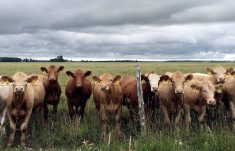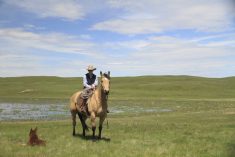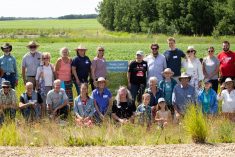Farmers may do regular soil tests but do they measure the nutrients that leave via harvested crops? There’s a calculator for that.
The Prairie Nutrient Removal Calculator helps farmers calculate or anticipate those numbers. Although not a new idea, it’s the only one designed specifically for Western Canadian farmers.
“Whether you’re in Alberta, Saskatchewan or Manitoba, this data is from those provinces and targeted towards those producers (and) the varieties being grown and the management practices being used here,” said University of Saskatchewan researcher Rich Farrell.
Read Also

Moo translator and methane measures: There’s an app for that
Dalhousie University researchers use artificial intelligence to create new dairy farm apps that analyze cattle sounds and measure methane.
It’s a tool for more accurate fertilizer management, said fellow researcher Fran Walley. Along with Farrell, she supervised the data collection that forms the backbone of the tool.
“If a farmer is interested in either maintaining soil fertility or in some instances even building it, it’s really important to know what your inputs are and what’s coming off the field as well,” she said. “Ideally you’re able to balance those things.”
Walley said the calculator is intended to complement but not replace producers’ existing soil testing programs, and possibly make them more robust.
“The one thing we feel really strongly about is that this calculator is meant to be used in conjunction with soil testing. This is not meant to be prescriptive by any means,” she said.
“One thing we learned is there is variability in uptake and removal values so if a farmer wants to know precisely what their crop removed, they have to measure their particular field. But this provides an estimate for them.”
Walley described the calculator, available at prairienutrientcalculator.info, as “super straightforward” to use.
“It’s really a matter of choosing what crops you’re interested in and then putting in (what) your anticipated or actual yield was for each one of the crops,” she said.
The option represent a cross-section of cereals, oilseeds and pulse crops commonly grown on the Prairies. The nutrients include nitrogen, phosphorus, potassium and Sulphur, as well as micronutrients such as copper, boron and zinc.
“The relative importance of micronutrients is being recognized more,” said Farrell. “We just felt it would be good to include those in the calculator.”
The tool was designed to overestimate nutrient removal to provide a conservative estimate, said Walley.
“The coefficient we used for each of the nutrients was based on the 75th percentile of the data we collected, so 75 per cent of the data would be below that coefficient and 25 per cent would be above.”
The three-year research project that provided the calculator’s data ultimately saw the collection of more than 2,200 grain and biomass samples representing 14 different crops from commercial farms across the Prairies.
It started with a conversation about existing Western Canadian nutrient removal data, which was collected in 2001, and the need for updates.
Changes in agriculture over the past two decades — different crops, genetics, management strategies and crop rotations —represented an opportunity to build new and more relevant data sets.
The project, started in 2020, coincided with the pandemic, so there were roadblocks to navigate.
“The university essentially shut down and there were restrictions on who could be in the building and what you could do in the building and things like that,” said Farrell.
Enlisting agronomists in all three provinces lightened the workload, but it still proved difficult to ask farmers for access to land during a pandemic.
“We collected only grain samples over the first year and that was because one of the limitations was that the university would only let us have one person in a vehicle at a time and we also don’t travel with a single summer student in a vehicle,” said Walley.
Industry support from government and producer groups helped push the project along.
“The fact that people were willing to do it and we collected as many samples as we did was just an indication of how much interest there was and the fact that people wanted it to progress despite the circumstances,” said Farrell.
Farmers may wonder about the impact of conservation practices that were either rarely used or still in their formative years in 2001.
Although the data was never intended to measure that impact, Walley pointed to examples that showed modest progress.
“We did notice, particularly with phosphorus and calcium, that estimates of nutrient removal on a per-bushel basis were a little bit lower than previous estimates,” she said.
“We’re not the only folks that have seen that. Some of the data coming out of the States saw a similar result and it suggests that nutrient use efficiency might be improving.
“We don’t know much about how accurately that data was collected or whether it came from research plots or commercial fields but it did raise some interesting questions for us. Is it the crops or management leading to more efficient use of nutrients?”
















